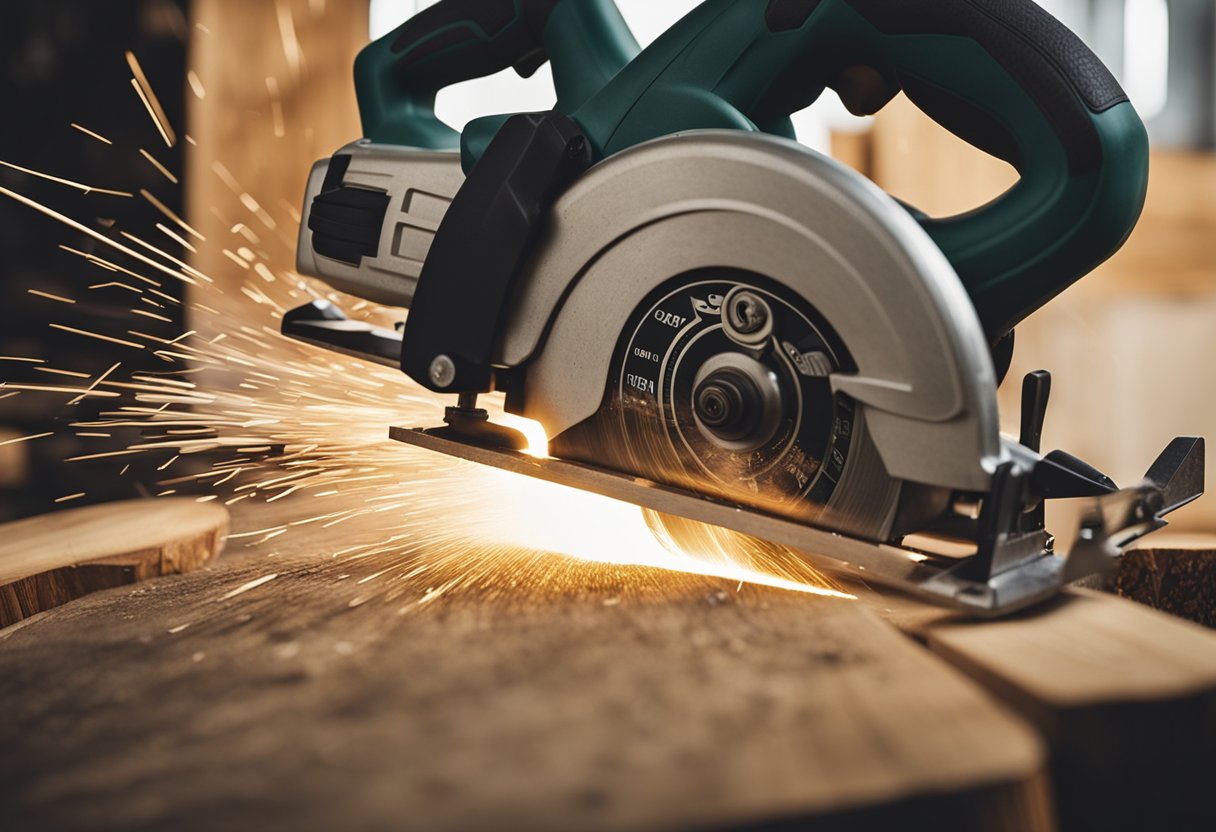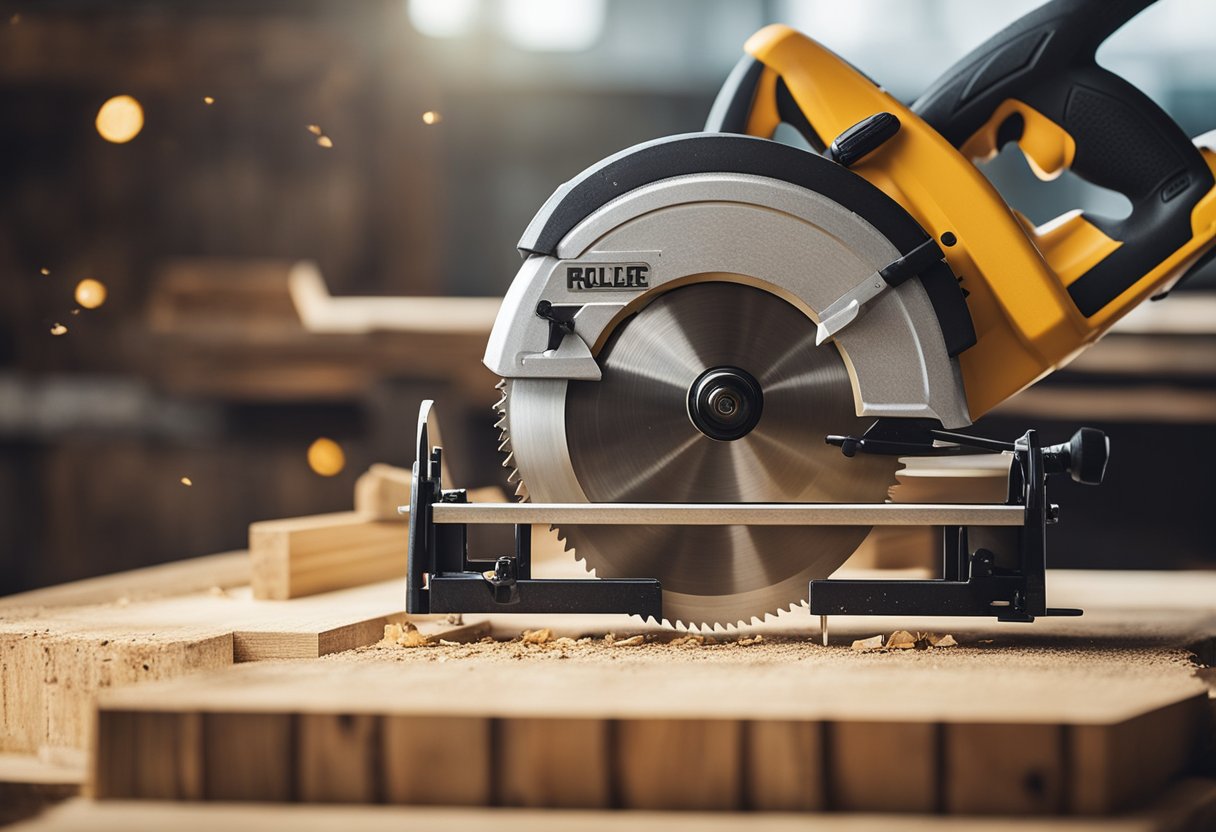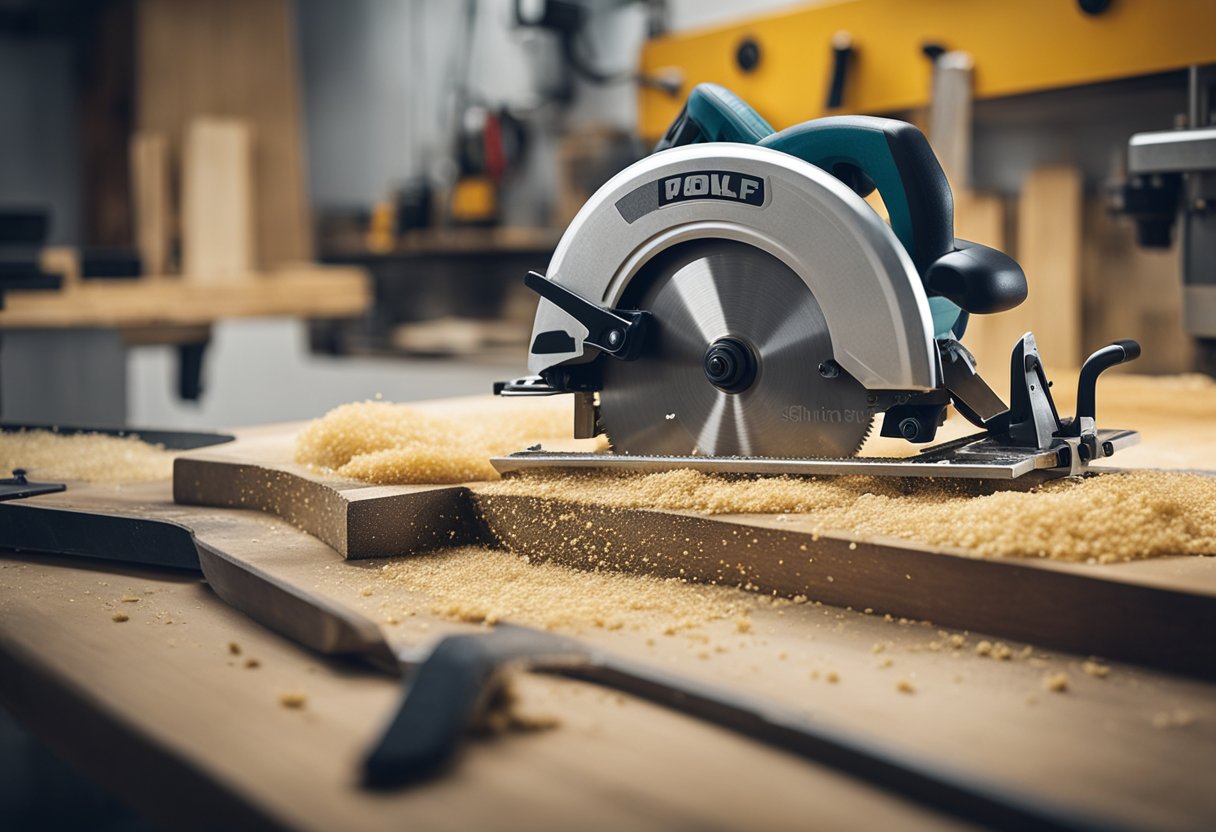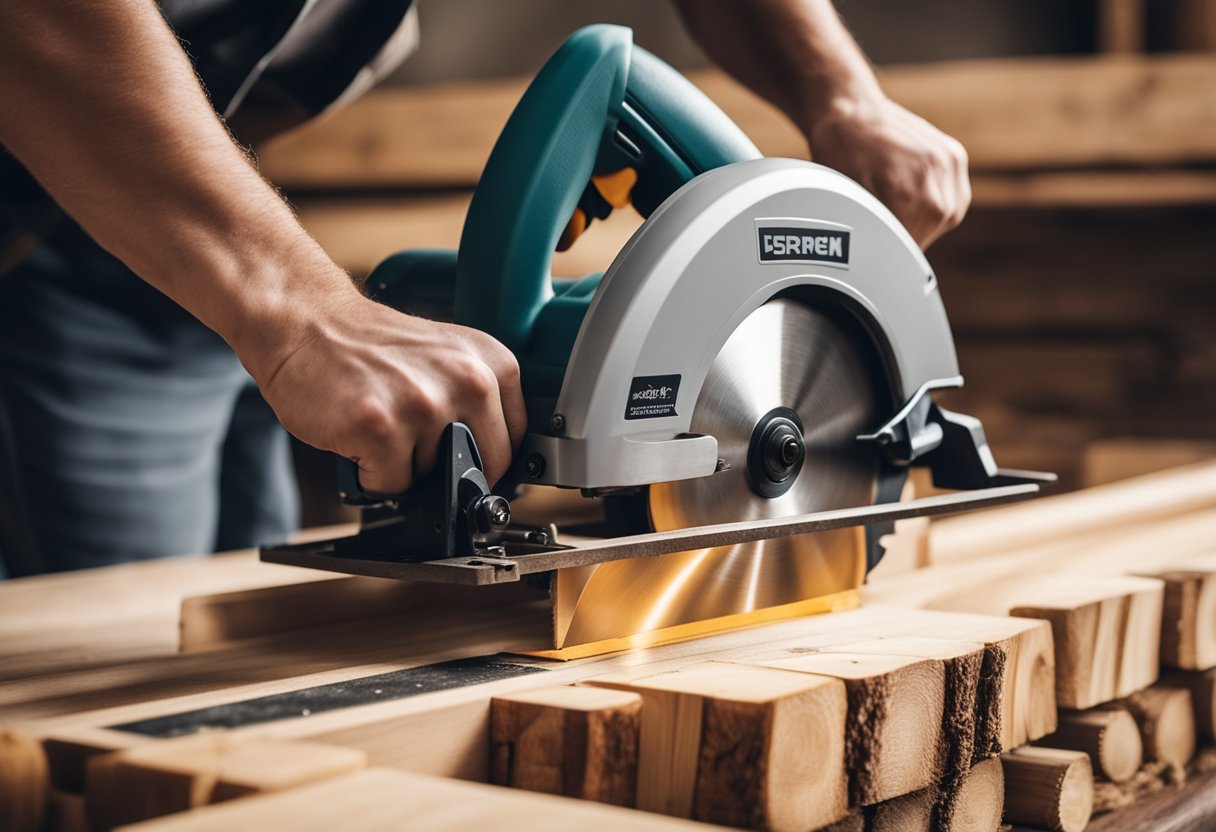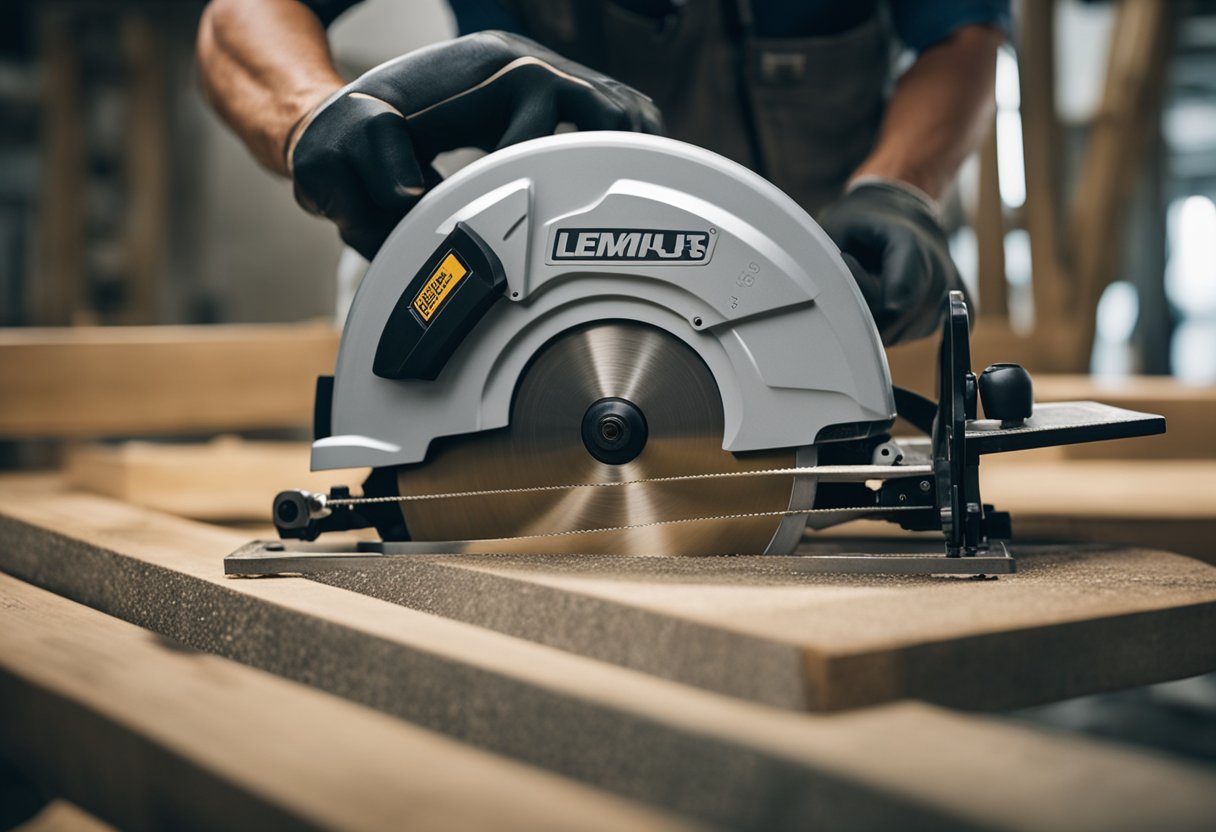As a DIY enthusiast, nothing can be more frustrating than a circular saw that doesn’t cut straight. The circular saw is a versatile tool that can make quick work of any cutting task, but when it doesn’t cut straight, it can lead to uneven cuts, wasted material, and time-consuming fixes. In this article, I’ll share my experience and knowledge on how to troubleshoot and solve the problem of a circular saw not cutting straight.
To understand why a circular saw is not cutting straight, it’s important to first understand how the saw works. A circular saw is a powerful tool that uses a rotating blade to cut through different materials. The blade is mounted on a motor that spins it at high speeds, and the saw is guided along the material to make the cut. The blade’s teeth cut through the material, and the saw’s base plate keeps the blade straight and in line with the cut.
There are several common reasons why a circular saw may not be cutting straight, such as a misaligned or dull blade, a warped blade, or a loose base plate. In this article, I’ll cover these reasons in detail and provide practical solutions to help you get your circular saw cutting straight again. I’ll also share tips on how to maintain cutting accuracy and troubleshoot any issues that may arise.
Key Takeaways
- Proper blade alignment is crucial for a circular saw to cut straight.
- Using guides and clamps can help improve cutting accuracy.
- Regular maintenance and care can prolong the life of your circular saw and ensure it cuts straight.
Understanding the Circular Saw
https://www.youtube.com/watch?v=uuSTXg-xCUg&embed=true
As a woodworking enthusiast, I understand the importance of having a reliable circular saw. A circular saw is a versatile and powerful tool that can make precise cuts on various materials such as wood, plastic, and metal.
A circular saw consists of several parts that work together to provide accurate and efficient cuts. The saw blade is the most crucial part of the saw, responsible for cutting through the material. The blade’s diameter determines the maximum depth of the cut, and the number of teeth determines the smoothness of the cut. A dull or damaged blade can cause the saw to drift, resulting in uneven cuts.
The motor is another essential part of the circular saw. It powers the blade and determines the saw’s cutting speed. A powerful motor can handle tough materials and make quick cuts, but it can also be heavier and more expensive.
The base plate or shoe is the part of the saw that rests on the material being cut. It provides stability and support to the saw during the cut. The base plate should be flat and level to ensure accurate cuts.
The saw arbor is the part of the saw that holds the blade in place. It is crucial to ensure the blade is securely attached to the arbor to prevent wobbling during the cut.
Lastly, the saw shoe is the part of the saw that rests on the workpiece. It is essential to keep the saw shoe in contact with the material being cut throughout the cut to prevent the saw from drifting.
Understanding the different parts and functions of a circular saw is crucial for achieving straight and accurate cuts. In the following sections, we will explore common reasons why a circular saw may not be cutting straight and how to fix them.
Common Reasons for Not Cutting Straight
https://www.youtube.com/watch?v=YPz1orpvbyI&embed=true
When using a circular saw, it is essential to ensure that it is cutting straight. However, there are several reasons why a circular saw may not be cutting straight.
One of the most common reasons why a circular saw may not be cutting straight is due to a dull blade. A dull blade can cause the saw to wander off course, resulting in a crooked cut. To avoid this, it is essential to ensure that the blade is sharp before using it.
Another reason why a circular saw may not be cutting straight is due to a misaligned or loose blade. When the blade is not correctly aligned with the base plate, it can cause the saw to wobble and create uneven cuts. To avoid this, it is essential to ensure that the blade is correctly installed and tightened.
A warped saw blade can also cause a circular saw to not cut straight. When a blade is warped, it will not spin evenly, causing the saw to wobble and create uneven cuts. To avoid this, it is essential to ensure that the blade is not warped before using it.
If the blade is installed incorrectly or the saw arbor is loose, it can cause the blade to move around, resulting in a crooked cut. Therefore, it is essential to ensure that the blade is correctly installed and tightened.
Finally, feeding the saw too fast can also cause the saw to not cut straight. When the saw is fed too fast, it can cause the blade to wobble and create uneven cuts. Therefore, it is essential to ensure that the saw is fed at a consistent speed to achieve straight cuts.
In summary, there are several reasons why a circular saw may not be cutting straight, including a dull blade, misaligned or loose blade, warped saw blade, incorrectly installed blade, saw arbor, uneven cuts, and fast feeding. By ensuring that the blade is sharp, correctly installed, and fed at a consistent speed, you can achieve straight cuts with your circular saw.
Importance of Proper Blade Alignment
https://www.youtube.com/watch?v=PKMgUSiSaj4&embed=true
As a professional woodworker, I can confidently say that proper blade alignment is crucial for a circular saw to cut straight. A misaligned blade can cause the saw to veer off course, resulting in uneven cuts and wasted materials.
Blade alignment refers to the position of the blade in relation to the base plate of the saw. If the blade is not perpendicular to the base plate, it will not cut straight. It is essential to check the alignment of the blade before making any cuts.
One way to check blade alignment is to use a square. Place the square against the blade and the base plate to ensure that they are at a 90-degree angle. If they are not, adjust the blade until it is perpendicular to the base plate.
Proper blade alignment is also important for safety reasons. A misaligned blade can cause kickback, which is when the saw suddenly jerks back towards the user. Kickback can be dangerous and cause serious injuries.
In addition to blade alignment, the angle of the blade can also affect the straightness of the cut. If the blade is tilted, it will not cut straight. It is important to adjust the angle of the blade to ensure that it is perpendicular to the workpiece.
In conclusion, proper blade alignment is essential for a circular saw to cut straight and safely. It is important to check the alignment of the blade before making any cuts and to adjust it as necessary. By doing so, you can ensure that your cuts are accurate and that you are using your saw safely.
Working with Guides and Clamps
https://www.youtube.com/watch?v=N8ufCdMYV7w&embed=true
When using a circular saw, it’s crucial to work with guides and clamps to ensure a straight and accurate cut. A guide is a tool that helps to keep the saw blade straight and aligned with the cutting line. It can be a straight edge, a guide rail, or a rip fence that attaches to the saw base. A clamp is a device that holds the workpiece in place and prevents it from moving during the cut.
To use a guide, I first mark the cutting line on the workpiece with a pencil or a marker. Then, I align the guide with the cutting line and clamp it to the workpiece. The guide should be positioned in a way that allows the saw blade to cut along the line without touching the guide. If the guide is too close to the blade, it can cause binding and kickback.
When using a rip fence, I adjust it to the desired width of the cut and lock it in place. The rip fence should be parallel to the saw blade and the cutting line. If it’s not aligned correctly, it can cause the saw to cut at an angle.
Clamps are essential when working with guides because they hold the workpiece in place and prevent it from moving during the cut. I use at least two clamps to secure the workpiece to the table or the sawhorse. The clamps should be positioned in a way that doesn’t interfere with the guide or the saw blade.
The angle of the cut can also affect the straightness of the cut. If I need to make an angled cut, I use a bevel gauge or a protractor to measure the angle and adjust the saw accordingly. I also use a guide to ensure that the saw blade stays aligned with the cutting line.
In summary, using guides and clamps is essential when using a circular saw. They help to ensure a straight and accurate cut and prevent binding and kickback. When working with guides, I make sure that they are positioned correctly and not too close to the blade. When using clamps, I use at least two and position them in a way that doesn’t interfere with the guide or the blade. Finally, I measure the angle of the cut and adjust the saw accordingly.
Maintaining Cutting Accuracy
https://www.youtube.com/watch?v=jBqlxw_hCjs&embed=true
As a woodworker, I know how frustrating it can be to have a circular saw that doesn’t cut straight. Not only does it waste valuable time, but it can also lead to inaccurate cuts that can ruin a project. That’s why maintaining cutting accuracy is essential for any circular saw user.
One of the most important factors in maintaining cutting accuracy is using a sharp blade. A dull blade can cause the saw to veer off course, resulting in uneven cuts. It’s important to check the blade regularly and replace it when necessary. I usually replace my blade when I notice that it’s not cutting as smoothly as it used to.
Another factor that can affect cutting accuracy is the cutting depth. If the blade is set too deep, it can cause the saw to bind and make it difficult to control. On the other hand, if the blade is set too shallow, it can cause the saw to bounce and produce uneven cuts. I always make sure to adjust the cutting depth according to the thickness of the material I’m cutting.
In addition to blade sharpness and cutting depth, it’s also important to ensure that the base plate is set at a 90-degree angle to the blade. A misaligned base plate can cause the saw to cut at an angle, resulting in inaccurate cuts. I always use a square to check the alignment of the base plate before making any cuts.
Finally, it’s important to use a straight edge as a guide when making long cuts. This can help keep the saw on track and produce straight cuts. I usually use a piece of scrap wood as a guide, clamping it to the material I’m cutting to ensure that the saw stays on course.
By following these tips, I’ve been able to maintain cutting accuracy with my circular saw and produce straight, accurate cuts every time.
Troubleshooting and Solutions
When a circular saw is not cutting straight, it can be frustrating and time-consuming. However, there are several troubleshooting steps and solutions that can help resolve the issue.
Troubleshooting
First, check to make sure that the blade is secure and properly attached to the saw. A loose or improperly attached blade can cause the saw to wobble and cut unevenly. If the blade is secure, check to see if it is dirty or dull. A dirty or dull blade can cause the saw to cut poorly and leave ragged edges. If the blade is dirty, clean it with a soft cloth. If it is dull, replace it with a new blade.
Next, check to see if the saw is level. A saw that is not level can cause the blade to cut at an angle, resulting in an uneven cut. Use a level to check the saw and adjust the feet or base plate as needed to ensure that it is level.
Solutions
If the blade is properly secured and clean, and the saw is level, there are several solutions that can help ensure a straight cut. First, use a track saw or a sliding workpiece to guide the saw and keep it on a straight path. This can help prevent the saw from wandering off course and cutting unevenly.
Another solution is to control the saw’s speed and pressure. Pushing too hard or going too fast can cause the blade to wander and cut unevenly. Try slowing down and applying gentle pressure to keep the saw on track.
Finally, consider widening the kerf path. The kerf is the width of the cut made by the saw blade. Widening the kerf path can help prevent the saw from binding and wandering off course. This can be done by adjusting the saw blade or by using a wider blade.
If none of these solutions work, it may be time to replace the blade or even the saw itself. By following these troubleshooting steps and solutions, you can help ensure that your circular saw cuts straight and accurately every time.
Regular Maintenance and Care
As an experienced woodworker, I know that regular maintenance and care are essential for keeping a circular saw in good working condition. A well-maintained saw can help you achieve precise cuts and extend the life of your saw blade. Here are some tips for maintaining and caring for your circular saw:
Keeping the Blade Sharp
One of the most important things you can do to maintain your saw’s cutting ability is to keep the blade sharp. A dull blade will not only produce ragged cuts but also put unnecessary stress on the saw’s motor, which can lead to overheating and other problems. I recommend using high-quality saw blades made of tungsten carbide, which are durable and can stay sharp for a long time.
Cleaning and Lubricating the Saw
Another essential aspect of saw maintenance is keeping it clean and well-lubricated. Sawdust and other debris can accumulate inside the saw, causing friction and reducing the saw’s efficiency. Therefore, I always make sure to clean the saw thoroughly after each use, using a soft brush to remove sawdust and other debris.
I also lubricate the saw’s moving parts, such as the blade guard, pivot points, and depth adjustment mechanism, with a light oil. This helps reduce friction and ensure that the saw operates smoothly.
Proper Storage
When not in use, I store my circular saw on a workbench or sawhorse, where it is protected from dust and other environmental factors. If you have a portable saw, make sure to store it in a dry, secure location where it won’t be knocked over or damaged.
Using a Jig
If you need to make precise cuts, I recommend using a jig to guide the saw. A jig is a device that holds the saw steady and helps you make straight cuts. There are many different types of jigs available, including those designed for specific types of cuts, such as bevel cuts or dado cuts.
Controlling the Weight
Finally, it’s important to consider the weight of the saw when using it. A heavy saw can be difficult to control, especially when making long cuts. Therefore, I recommend choosing a saw that is comfortable for you to use and adjusting the weight of the saw if necessary, by adding or removing attachments or using a lighter blade.
By following these tips for regular maintenance and care, you can keep your circular saw in top condition and achieve precise, clean cuts every time.
Practical Tips for Better Control and Precision
As someone who has worked with circular saws for years, I have learned a few practical tips that can help you achieve better control and precision when cutting with a circular saw.
Use a Speed Square
A speed square is a handy tool that can help you make straight cuts with your circular saw. Simply place the speed square against the edge of your workpiece and use it as a guide for your saw. This will help you make straight cuts and ensure that your cuts are at a 90-degree angle to the workpiece.
Clamp Your Workpiece
Clamping your workpiece to your work surface can help you achieve better control and precision when cutting with a circular saw. This will prevent the workpiece from moving as you are making the cut, and it will free up both your hands to be able to hold the saw securely and guide it straight in the cut.
Check Your Blade
Make sure your blade is sharp and properly aligned with the baseplate. A dull or misaligned blade can cause inaccuracies in your cuts, and can even cause smoking and chips in the wood.
Practice and Gain Experience
Like with any skill, practice makes perfect. The more you work with your circular saw, the better you will become at controlling it and achieving precision in your cuts. Take the time to practice on scrap pieces of wood before moving on to your actual workpiece.
Consider the Thickness of Your Workpiece
If your workpiece is particularly thick, you may need to adjust the depth of your blade to ensure that you make a clean cut all the way through. Make sure to adjust the blade height before you start cutting to avoid any mistakes.
Be Mindful of the Components
It is important to be mindful of the components of your circular saw, such as the arbor and baseplate. Make sure they are properly secured and in good condition before starting your project to avoid any accidents or inaccuracies.
By following these practical tips, you can achieve better control and precision when cutting with a circular saw. Remember to always prioritize safety and take the time to practice and gain experience with your tool.
Frequently Asked Questions
How to adjust the blade depth on a circular saw?
To adjust the blade depth on a circular saw, locate the depth adjustment lever or knob on the saw. Loosen the lever or turn the knob to adjust the blade depth and tighten it back up once the desired depth is achieved. Make sure to adjust the blade depth before starting the saw to avoid accidents.
Why is my circular saw cutting at an angle?
If your circular saw is cutting at an angle, it could be due to a misaligned blade or base plate. Check to see if the blade is properly aligned with the base plate and if the base plate is set at a 90-degree angle to the blade. Adjust as necessary. Also, make sure that you are holding the saw properly and applying even pressure to the base plate.
How to square a circular saw?
To square a circular saw, start by checking the blade and base plate alignment. Make sure that the blade is properly aligned with the base plate and that the base plate is set at a 90-degree angle to the blade. Then, use a square to check the angle of the blade and adjust as necessary. Finally, make sure that you are holding the saw properly and applying even pressure to the base plate.
Why can’t I cut a straight line with my circular saw?
If you can’t cut a straight line with your circular saw, it could be due to a variety of factors. Check to see if the blade is properly aligned with the base plate and if the base plate is set at a 90-degree angle to the blade. Also, make sure that you are holding the saw properly and applying even pressure to the base plate. If the blade is dull or worn out, replace it with a new one.
What causes a circular saw blade to bind?
A circular saw blade can bind if it is dull, damaged, or if the saw is not powerful enough for the material being cut. Make sure that the blade is sharp and in good condition before use. Also, make sure that the saw is powerful enough for the material being cut and that you are using the correct blade for the job.
Why does my circular saw pull to one side?
If your circular saw is pulling to one side, it could be due to a misaligned blade or base plate, or uneven pressure being applied to the saw. Check to see if the blade is properly aligned with the base plate and if the base plate is set at a 90-degree angle to the blade. Also, make sure that you are holding the saw properly and applying even pressure to the base plate.

Hi, I’m Sal Muller of Tooltrip.com. My DIY experience led me to understand essential power tools for home projects. Tooltrip.com guides enthusiasts and professionals in choosing right tools for any job. I provide concise top tool reviews for easier, efficient DIY.

